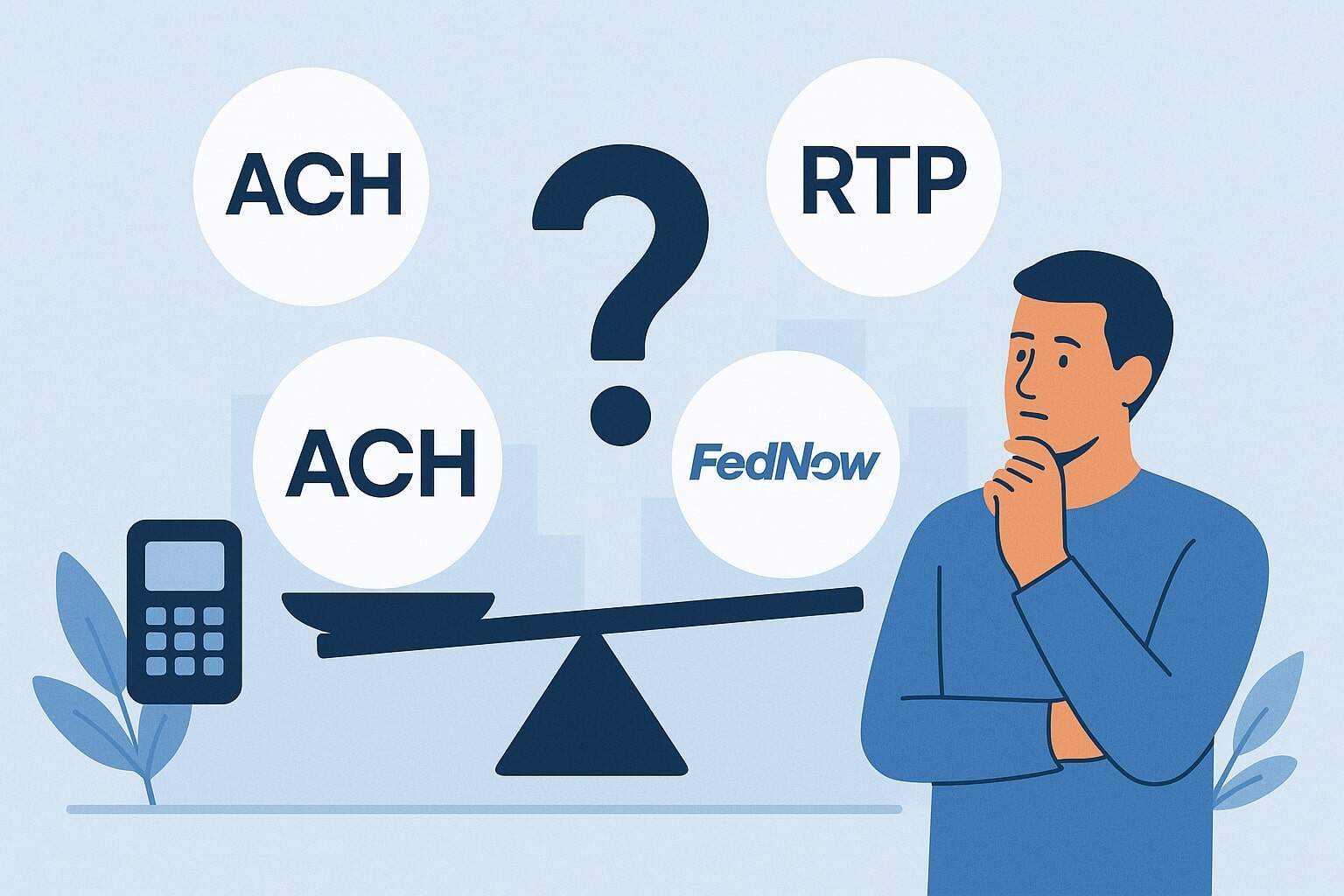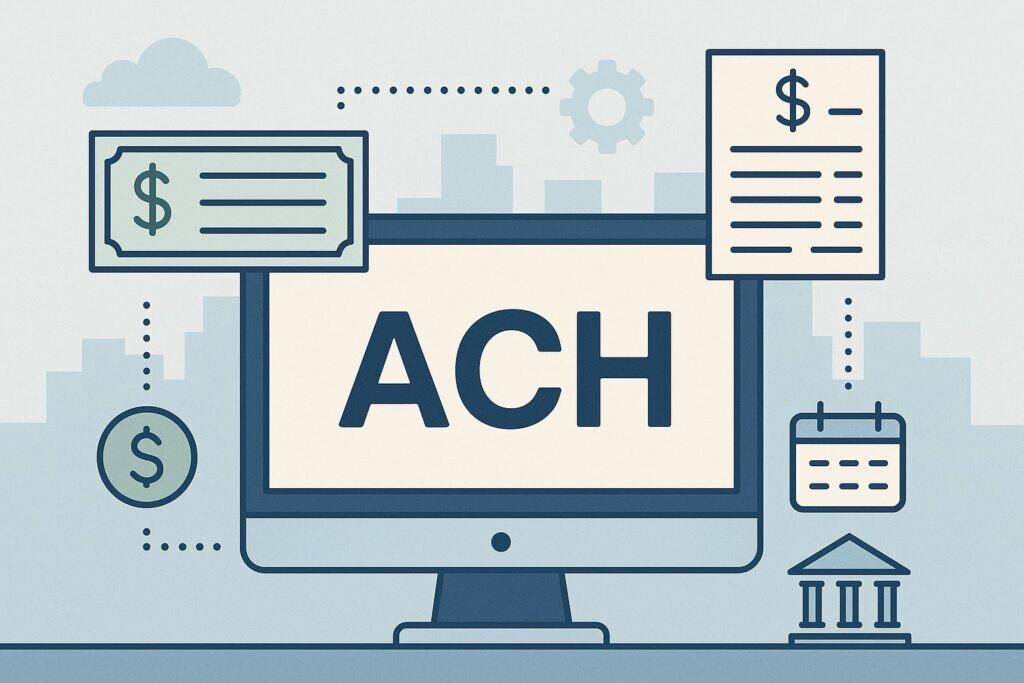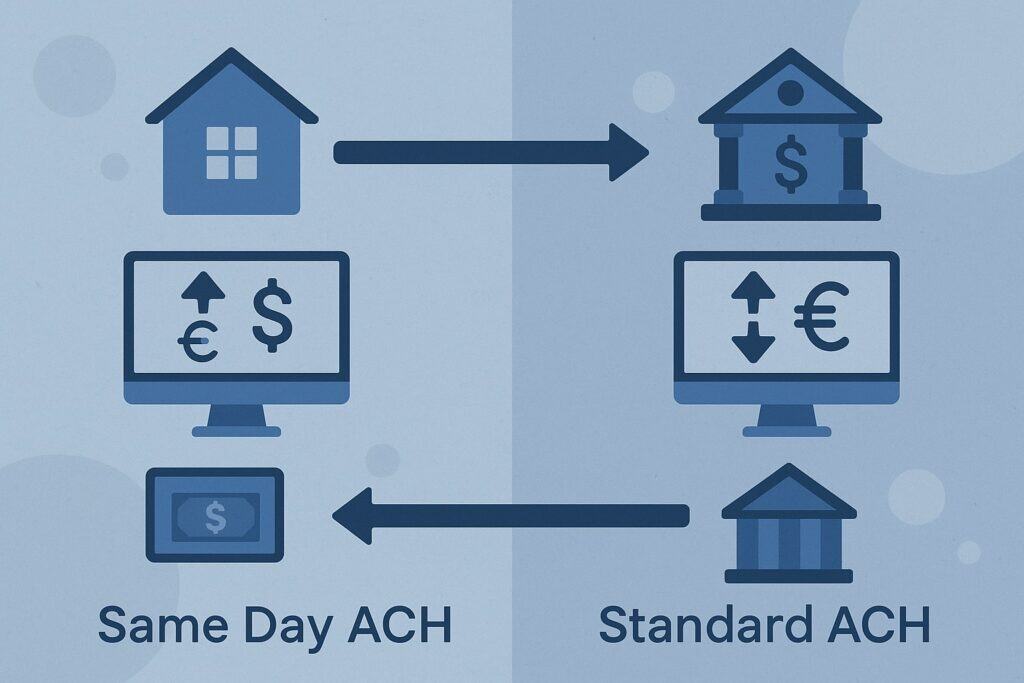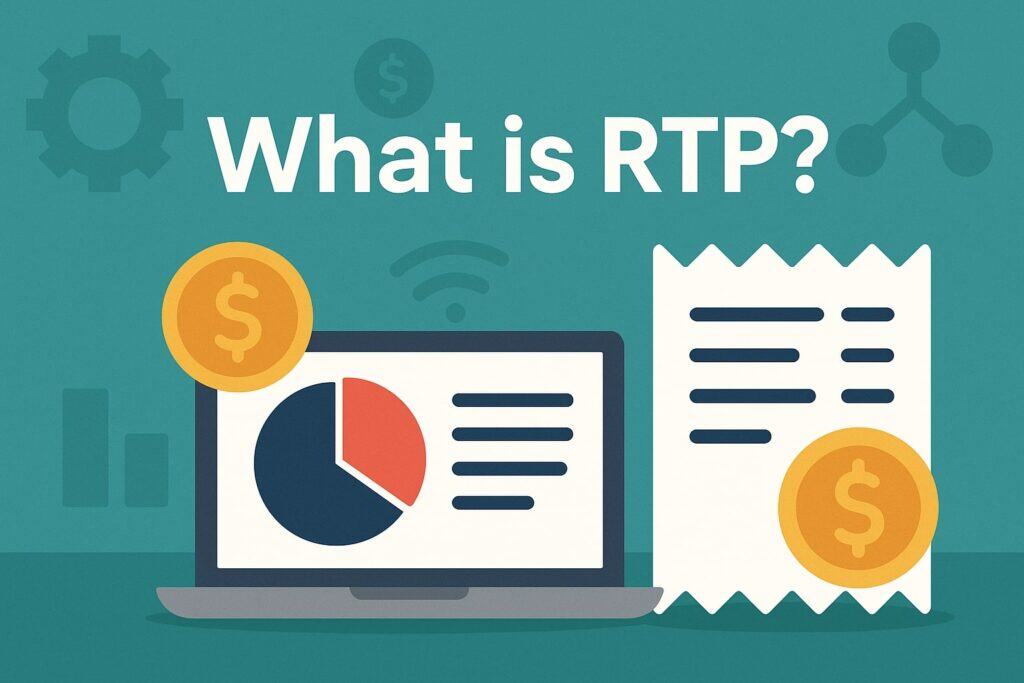
Comparing ACH, RTP, and FedNow: Which Is Right for You?
Choosing between ACH, RTP, and FedNow can feel complicated. Each rail moves money, but they solve different problems for U.S. businesses.
In this guide, you’ll learn how Automated Clearing House (ACH), The Clearing House RTP® network (RTP), and the Federal Reserve’s FedNow® Service compare on speed, limits, availability, cost, risk, and use cases.
You’ll also see a clear decision framework so you can pick the right rail for payroll, supplier payments, instant disbursements, and more. All insights assume U.S. banking and compliance standards.
If you need low-cost, high-volume payments and can accept a delay, ACH is the workhorse. If you need immediate, final, 24/7 settlement with rich messaging and higher limits, RTP is a proven private network that’s expanding fast.
If you want immediate settlement backed by the Federal Reserve with broad potential reach across the banking system, FedNow is the new public instant rail building momentum. As of 2025, RTP supports credit transfers up to $10 million per transaction, a major lift for B2B use cases.
FedNow currently has a $1 million maximum configurable limit with a default of $100,000, and the Fed has announced a planned increase to $10 million effective November 2025. Same Day ACH remains a faster ACH option with a $1 million per-payment cap, and volumes continue to climb.
What is ACH? The U.S. Batch-Payments Backbone for Everyday Business

ACH (Automated Clearing House) is the batch-based electronic funds transfer system used for payroll, vendor payments, and consumer debits. It’s reliable, cost-effective, and deeply integrated into U.S. finance.
ACH transactions typically settle in one to three banking days, though Same Day ACH offers faster posting within same-day windows. ACH shines when you’re pushing many payments at once, like payroll, or collecting recurring invoices with predictable timing.
ACH operates through two primary pathways: standard ACH and Same Day ACH. Standard ACH is scheduled into daily windows and uses next-day settlement timelines that vary by your originating depository financial institution (ODFI) and the receiving bank (RDFI).
Same Day ACH compresses the timeline with multiple intraday windows. The tradeoff is you’re still bound to bank-day cutoffs and returns processing cycles, so ACH is not “instant” in the real-time sense.
Cost is the ACH superpower. Unit pricing is often cents per payment, which keeps operating expenses low as your volume scales. ACH also supports a wide array of transaction codes for payroll (PPD), business payments (CCD/CTX), and consumer debits (WEB/PPD/TEL).
For many finance teams, ACH is the default rail because it is predictable, widely supported, and easy to reconcile.
Same Day ACH vs. Standard ACH: Speed, Dollar Caps, and Operations

Same Day ACH compresses settlement to the same business day using specific submission windows and bank cutoffs. It’s ideal when you need faster posting for payroll corrections, urgent supplier payments, or last-minute disbursements.
As of 2025, the Same Day ACH per-payment limit is $1 million, up from $100,000 in 2020 and $25,000 originally—a series of increases that unlocked more B2B flows. Nacha reports that 2024 Same Day ACH volume surpassed 1.2 billion payments totaling $3.2 trillion, reflecting business adoption for faster-but-still-batched payments.
Operationally, what matters is timing discipline. You must hit submission windows and understand your bank’s cutoff times. Returns can be processed in same-day windows by RDFIs, but adoption is uneven; a 2025 Nacha bulletin noted only 59% of RDFIs used Same Day windows for any returns, and many used them less than half the time.
ACH retains a defined returns framework (e.g., NSF, account closed, unauthorized), which affects certainty and cash-flow forecasting. ACH is not irrevocable at posting; you manage risk with validation, authorization, and monitoring rather than settlement finality.
What is RTP? The Private, Real-time Network with Rich Messaging and Finality

The Clearing House’s RTP network is a 24/7/365 instant payment rail. Payments are push-only credit transfers that settle in real time with immediate funds availability and irrevocability, giving you receipt certainty.
RTP uses ISO 20022 messaging and supports features like Request for Payment (RfP), enabling invoice-presentment and straight-through reconciliation.
Businesses adopt RTP for payroll earned-wage access, instant marketplace payouts, supplier payments that can’t wait, and high-urgency disbursements across insurance, healthcare, and logistics.
A critical 2024–2025 update: RTP’s per-transaction limit increased to $10 million, enabling high-value B2B payments like commercial real estate closings and treasury moves.
In 2025, TCH highlighted record value flows, including a $10 million payment and a 195% quarter-over-quarter jump in Q2 network value, underscoring enterprise-grade use cases.
Unlike ACH, RTP confers immediate finality; there are no traditional ACH-style returns after funds post. Risk controls shift to pre-payment validation, account name checks, limits, and fraud screening.
RTP’s strengths are speed, certainty, and messaging richness. Pricing is higher than ACH but competitive versus checks, wires, or cards for many flows.
With RfP, you can streamline collections and reduce reconciliation pain—remittances travel with the payment, improving straight-through processing and cash application.
What is FedNow? The Federal Reserve’s 24/7 instant rail with broad reach

FedNow is the Federal Reserve’s real-time credit transfer service, operating 24/7/365 with immediate funds availability and finality from the central bank operator. Like RTP, FedNow supports ISO 20022 messages and Requests for Payment.
The key differentiator is governance and reach: the Fed serves thousands of institutions via FedLine, so FedNow is positioned to deliver instant payments access across community banks and credit unions in addition to large banks.
As of early 2025, participating institutions can configure a maximum credit transfer limit up to $1 million, with a default of $100,000. The Fed has announced a planned increase to $10 million effective November 2025, designed to expand high-value use cases such as B2B payments and real-estate transactions.
FedNow launched with ISO 20022 support across core message types, aligning with the global standard and enabling structured remittance for cleaner reconciliation. In practice, FedNow can mirror RTP use cases—instant disbursements, supplier payments, insurance claims—but participation is bank-by-bank.
Your ability to send and receive on FedNow depends on your bank or payment provider’s enablement. Many businesses will benefit as adoption grows and limits rise.
Speed and settlement: “real time” vs. “same day” vs. “next day”
Speed is the headline difference between ACH, RTP, and FedNow. ACH is batch-based. Even Same Day ACH depends on bank-day windows and cutoff times; it is faster than standard ACH but not 24/7 instant.
The Federal Reserve publishes ACH (FedACH) processing schedules that show how eligibility and windows affect timing. RTP and FedNow deliver seconds-level posting, 24/7/365, with final settlement. That finality reduces operational overhead: there’s no waiting for returns, and funds are immediately usable.
In finance terms, finality shifts risk management from “post-payment exceptions” to “pre-payment controls.” With ACH, you plan for returns and reversals.
With RTP and FedNow, you need strong upfront validation, limits, and authentication because once you send, it’s done. This matters for treasury teams balancing liquidity and fraud controls.
Transaction limits and use-case ceilings
ACH has generous effective ceilings because it’s batch-based and not intrinsically capped the way instant rails are. The key cap to watch is Same Day ACH’s $1 million per-payment limit.
RTP now supports $10 million per credit transfer, opening more enterprise flows. FedNow’s current $1 million maximum and $100,000 default are expanding to $10 million in November 2025, which will materially change high-value instant use cases.
If you’re paying a property closing or a large supplier invoice that cannot wait, RTP’s $10M cap may already fit. If you plan to route those flows over FedNow, watch the 2025 limit change and confirm your bank’s configured limits, which can be lower than the network max.
Messaging, remittance, and reconciliation: the ISO 20022 advantage
RTP and FedNow both use ISO 20022 messages, which carry structured remittance data and support Request for Payment (RfP). That means better invoice detail, fewer exceptions, and cleaner auto-matching in your ERP.
ACH supports addenda records (especially CTX) for remittance, but it’s not as rich or standardized as ISO 20022 messaging on the instant rails.
Industry analysts and providers note that RTP adopted ISO 20022 early for a domestic system, while FedNow launched with ISO 20022 from day one—converging the U.S. with global standards and improving interoperability at the semantic level.
For CFOs, this is more than a technical detail: structured remittance reduces DSO, shortens cash-application cycles, and slashes manual work. If reconciliation is your pain point, instant rails’ messaging can deliver outsized ROI even if the payment itself could have traveled over ACH.
Availability and reach: who can you pay today?
ACH reach is unmatched; every U.S. bank supports it. That ubiquity is why ACH is the default rail for payroll and collections.
RTP’s reach depends on bank participation, but coverage has grown each quarter, and large institutions, fintechs, and many regionals enable it for send and/or receive. The strong 2025 value growth reflects higher-value transactions and broader enablement.
FedNow’s reach is expanding through the Federal Reserve’s network. Many community banks and credit unions are enabling receive first, then send. As limits rise to $10M in November 2025, expect larger corporates and real estate workflows to join in.
Confirm your bank’s current status for send and receive on both instant rails; your provider may already offer both, even if your primary bank is rolling out in phases.
Pricing and total cost: think beyond per-payment fees
ACH tends to be cheapest on a per-item basis, often just cents. Same Day ACH adds a premium but is still economical relative to wires and cards.
RTP and FedNow generally cost more per item than ACH but deliver value through instant certainty, 24/7 availability, lower exception handling, and richer remittance that reduces back-office costs. When you model total cost of ownership, include:
- Labor saved on reconciliation and exceptions
- Lower refund friction and better customer experience
- Reduced use of checks and wires
- Cash-flow benefit from immediate availability
Your bank or payment processor will quote specific fees for ACH, Same Day ACH, RTP, and FedNow. Compare all-in costs, not just network fees.
Risk, fraud, and compliance: where controls belong
ACH risk centers on returns and dispute windows. You need strong authorization, account validation (e.g., micro-deposits, instant account verification), and monitoring for NSF and unauthorized debits.
Same Day ACH compresses timing but keeps the returns framework. A Nacha 2025 bulletin noted many RDFIs still don’t process returns in same-day windows, which affects how quickly you see exceptions.
On instant rails, settlement finality shifts the risk curve. You must stop fraud before sending funds. Use multi-factor authentication, device and behavior analytics, account name/number checks, allow-lists, and per-payment and per-day limits.
Leverage RfP to reduce “push payment fraud” risk by letting payees request payment with structured details rather than relying on free-form account entry. ISO 20022 data helps drive smarter risk decisions and automated holds when signals look suspicious.
Regulatory expectations remain high across rails: KYC/KYB, BSA/AML, sanctions screening, and error-resolution procedures apply regardless of network.
For ACH, stay current with Nacha rules; for RTP, monitor TCH rules and your bank’s program; for FedNow, review Federal Reserve operating circulars and your bank’s FedNow terms.
Implementation and integration: what it takes to go live
- ACH: Most ERPs, payroll systems, and AP platforms already export NACHA files or integrate via your bank’s API. Go-live involves file testing, cutoffs, and returns handling. Add Same Day ACH by enabling the service and adjusting submission schedules.
- RTP: Integration usually happens via your bank or a payment processor offering RTP APIs and RfP endpoints.
You’ll build or configure message handling, real-time posting, webhooks, and reconciliation workflows that consume ISO 20022 data. Treasury policies should define instant-payment approvals, limits, and after-hours procedures. - FedNow: Similar to RTP, but connectivity is through banks that expose FedNow APIs or through fintech gateways.
Ensure your provider supports both send and receive and is prepared for the 2025 limit changes. Make sure your back office can accept and parse ISO 20022 messages for straight-through posting.
For all rails, align on exception handling, customer support SLAs, audit logging, and controls for dual approval and segregation of duties.
Use cases: how U.S. businesses match rails to real problems
- Payroll & contractor payouts: ACH remains ideal for scheduled payroll. For on-demand or earned-wage access, RTP or FedNow gives workers instant funds. With rising RTP caps, high-earner bonus payouts can now move instantly up to $10 million if policy allows.
- Supplier payments & cash-on-delivery: ACH for routine net terms. RTP/FedNow for urgent releases, COD, or when inventory ships only after funds clear. The finality of instant rails removes “waiting for the ACH to clear.”
- Insurance & claims: Instant rails speed claim disbursements and reduce check costs. ISO 20022 remittance improves claimant communication.
- Marketplaces & gig platforms: Instant payouts keep sellers engaged. Use RTP/FedNow for nightly or on-demand pushes. ACH batches handle large scheduled sweeps.
- Real estate & high-value B2B: RTP’s $10M limit enables closings and large invoices. FedNow’s announced $10M limit from November 2025 expands options.
- Collections: Use RfP on RTP and FedNow to push invoices with structured data and allow customers to pay instantly from their bank.
Decision framework: how to pick ACH, RTP, or FedNow for each flow
Ask these questions for every payment flow:
- How fast must funds settle?
- If seconds: RTP or FedNow.
- If the same business day is fine: Same Day ACH.
- If the next day is fine: standard ACH.
- If seconds: RTP or FedNow.
- What is the payment size?
- Up to $1M: all three rails; FedNow default limits may require bank configuration.
- Up to $10M: RTP today; FedNow from Nov 2025.
- Up to $1M: all three rails; FedNow default limits may require bank configuration.
- What messaging do you need?
- If you need RfP and structured remittance for straight-through reconciliation, favor RTP or FedNow.
- If you need RfP and structured remittance for straight-through reconciliation, favor RTP or FedNow.
- What’s the receiving bank able to accept today?
- ACH is universal.
- RTP/FedNow require counterparty bank enablement for receive and, if relevant, send.
- ACH is universal.
- What is the risk posture?
- If you need finality now, choose instant rails with strong pre-payment controls.
- If returns handling is acceptable, ACH remains efficient.
- If you need finality now, choose instant rails with strong pre-payment controls.
- Total landed cost?
- Model fees, labor saved, and working-capital value.
Often, the right answer is multi-rail. Many organizations keep ACH as the default for routine payments, add Same Day ACH for urgent batches, then layer RTP and FedNow for instant, high-impact flows.
Side-by-side comparison: ACH vs. RTP vs. FedNow (highlights)
- Speed & availability
- ACH: next-day to 2–3 days; Same Day within bank-day windows.
- RTP & FedNow: real-time, 24/7/365 with immediate availability.
- ACH: next-day to 2–3 days; Same Day within bank-day windows.
- Settlement & reversals
- ACH: posted entries can be returned; defined return codes and windows.
- RTP & FedNow: final and irrevocable once posted; manage risk before send.
- ACH: posted entries can be returned; defined return codes and windows.
- Limits
- Same Day ACH: up to $1M/payment.
- RTP: up to $10M/payment.
- FedNow: configurable up to $1M today, $10M from Nov 2025; default $100k.
- Same Day ACH: up to $1M/payment.
- Messaging
- ACH: addenda/CTX; good but limited structure.
- RTP & FedNow: ISO 20022 with RfP and rich remittance.
- ACH: addenda/CTX; good but limited structure.
- Reach
- ACH: universal in the U.S.
- RTP & FedNow: expanding bank participation; verify your counterparty’s status.
- ACH: universal in the U.S.
Implementation checklist: getting business-ready (ACH, RTP, FedNow)
- Bank & provider readiness
- Confirm which rails your bank or processor supports for send and receive.
- For FedNow, verify configured transaction limits and timeline for the Nov 2025 uplift.
- Confirm which rails your bank or processor supports for send and receive.
- Connectivity & formats
- ACH: file or API; align CCD/CTX codes and addenda.
- RTP/FedNow: API integration, webhooks, ISO 20022 message mapping.
- ACH: file or API; align CCD/CTX codes and addenda.
- Controls & approvals
- Dual approvals, per-transaction and daily limits, after-hours policies.
- Pre-payment validation for instant rails.
- Dual approvals, per-transaction and daily limits, after-hours policies.
- Risk & compliance
- KYC/KYB, BSA/AML, sanctions screening, monitoring.
- ACH returns handling workflow; instant exception handling playbooks.
- KYC/KYB, BSA/AML, sanctions screening, monitoring.
- Reconciliation & posting
- ERP/treasury mapping for ISO 20022 fields; RfP invoicing.
- ERP/treasury mapping for ISO 20022 fields; RfP invoicing.
- Customer & vendor onboarding
- Collect correct routing/account details.
- Offer RfP and instant payout options where they add value.
- Collect correct routing/account details.
Real-world patterns: when businesses choose each rail
- Subscription software (SaaS): ACH for monthly pulls to control costs; RfP on RTP/FedNow for late invoices to speed cash.
- Staffing & gig: ACH for payroll cycles; RTP/FedNow for instant end-of-shift payouts.
- Wholesale distribution: ACH for routine supplier payments; RTP for urgent shipments when trucks are waiting at the dock.
- Insurance & health: ACH for scheduled capitation; instant rails for claims and member refunds.
- Real estate & escrow: RTP now fits many closings with the $10M cap; FedNow’s $10M cap coming Nov 2025 broadens options.
Future trends to watch in 2025 and beyond
- Rising instant limits: RTP is already at $10M; FedNow will align in Nov 2025, unlocking more high-value B2B.
- Deeper ISO 20022 adoption: Rich remittance will reduce exceptions and speed cash application.
- Broader bank participation: Expect more community banks and credit unions to enable instant rails, improving reach and reducing “counterparty not enabled” roadblocks.
- Operational convergence: Many treasury teams will standardize on multi-rail gateways, routing by rules (amount, urgency, recipient capability, cost).
FAQs
Q.1: Is ACH going away now that RTP and FedNow exist?
Answer: No. ACH remains the U.S. backbone for payroll, B2B settlement, and consumer debits. Instant rails complement ACH for urgent, high-impact payments.
Q.2: How “instant” are RTP and FedNow really?
Answer: They post in seconds and operate 24/7/365 with immediate funds availability and settlement finality. That’s different from Same Day ACH, which is still tied to bank-day windows.
Q.3: What are the current payment limits?
Answer: Same Day ACH: $1M/payment. RTP: $10M/payment. FedNow: $1M max configurable today with $100k default, rising to $10M in Nov 2025. Always verify your bank’s configured limits.
Q.4: Do RTP and FedNow support requests for payment and invoice data?
Answer: Yes. Both use ISO 20022 with RfP support, which improves reconciliation and customer experience.
Q.5: Are instant payments reversible?
Answer: Not in the traditional ACH sense. They are designed to be final upon posting. Build strong pre-payment fraud controls and verification procedures.
Q.6: What if my vendor can’t receive RTP or FedNow?
Answer: Fallback to ACH. Keep multi-rail options so you can route based on the counterparty’s capabilities.
Q.7: Is Same Day ACH still useful if I have instant rails?
Answer: Yes. Same Day ACH is cost-effective for same-day batches, and it’s widely supported. It fills a gap between standard ACH and instant payments. 2024 volumes show growing adoption.
Q.8: Which rail should I use for real estate or high-value B2B payments?
Answer: RTP already supports up to $10M and is used for high-value, time-critical closings. FedNow will support up to $10M starting Nov 2025. Check your bank’s configuration and operational policies.
Conclusion
ACH, RTP, and FedNow aren’t rivals so much as complementary tools. ACH delivers low-cost scale for routine payroll, AP, and collections. Same Day ACH compresses time for urgent batches.
RTP and FedNow provide instant, final settlement with rich ISO 20022 data—perfect for payouts, urgent supplier payments, and customer experiences where seconds matter. With RTP at $10M and FedNow moving to $10M in Nov 2025, instant rails now reach into high-value B2B territory.
The smartest approach is multi-rail. Enable ACH, Same Day ACH, RTP, and FedNow through your bank or payments partner. Define routing rules based on amount, urgency, counterparty capability, cost, and reconciliation needs. Strengthen pre-payment controls for instant rails, and keep robust returns handling for ACH.
When you match each payment to the right rail, you cut costs, speed cash flow, and deliver a modern payment experience that meets U.S. customer and supplier expectations today—and scales for tomorrow.